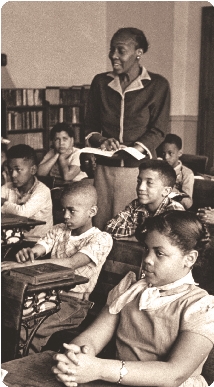“Separate But Equal”
Throughout his career, Thurgood Marshall fought the “separate but equal” rule. This rule was created in 1896 by the Supreme Court. It said that states could offer separate services to African Americans and whites as long as the services were close to equal, but actually they often were not.
Many states passed laws saying that local school districts could decide whether to have separate schools for blacks and whites. The result was that all schools in the South were segregated. And there was nothing “equal” about the education black children were given in their poor, crowded schools.
After World War II, many Southern states tried to improve their blacks-only schools. They wanted to show that these schools were equal, but their efforts were too little and too late. By 1952, there were several court cases about segregated schools. The most famous case involved an eight-year-old girl named Linda Brown.
Linda’s family lived close to a public school in Topeka, Kansas, but that school accepted only white students. So Linda had to travel by bus to a blacks-only school. To reach their bus stop, she and her sister had to walk through a dangerous railroad yard. Early in 1951, the Browns and some other African American families decided to take the local school district to court. In July, the local school board promised they would end segregation “as soon as possible.” But that wasn’t good enough for the Browns.

Linda Brown (lower right) in a segregated classroom